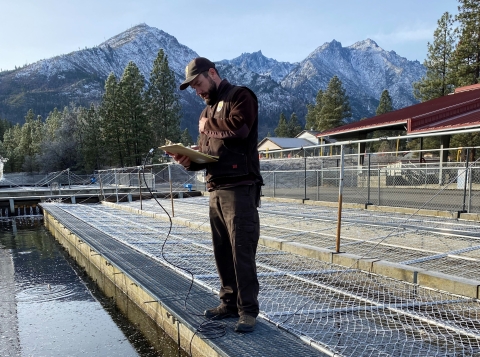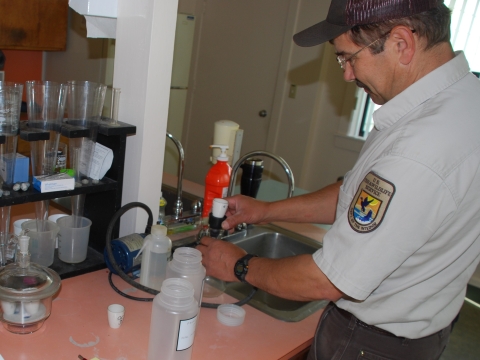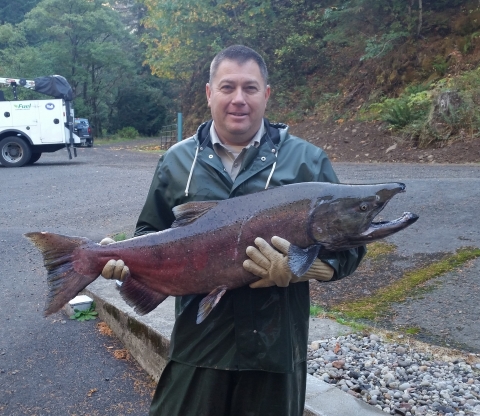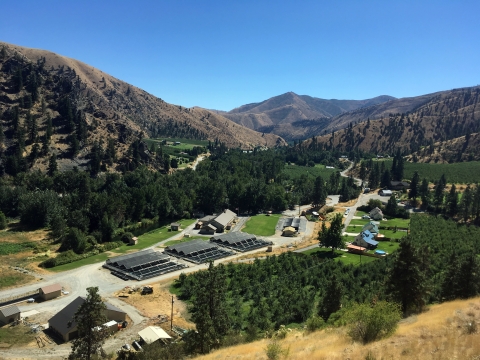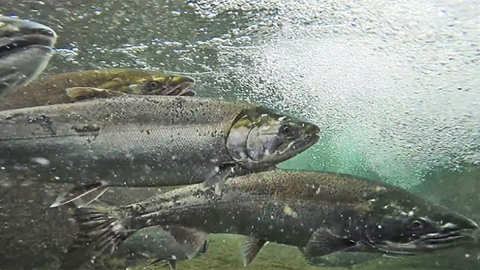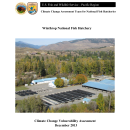States
Idaho, Oregon, WashingtonEcosystem
Lake, River/streamThe U.S. Fish and Wildlife Service is committed to leading the way in addressing and adapting to the impacts of climate change. One of the ways that the Service is addressing the challenges presented by climate change is through evaluations of climate change vulnerability at National Fish Hatcheries (NFHs). In 2011, Service hatcheries across the nation began conducting qualitative assessments to identify the most significant adaptation risks at each facility and plan proactive response strategies to address these risks.
The Process
Identifying Vulnerability
Vulnerability to climate change climate change
Climate change includes both global warming driven by human-induced emissions of greenhouse gases and the resulting large-scale shifts in weather patterns. Though there have been previous periods of climatic change, since the mid-20th century humans have had an unprecedented impact on Earth's climate system and caused change on a global scale.
Learn more about climate change is a function of several factors:
- Sensitivity is the degree to which a system is likely to be affected by climate change. For example, a NFH that is already rearing fish at maximum fish densities will be very sensitive to negative impacts of climate change.
- Exposure is the quantified prediction of change (e.g., water temperature) that may occur at a particular NFH as a result of climate change.
- Impact is defined as the combination of sensitivity and exposure. A sensitive NFH may be impacted by even a small change in climate. Conversely, if exposure is great enough, it may also affect less sensitive NFHs.
- Adaptation is defined as how well a system may be able to adapt to change. Some NFHs will be able to adapt to climate change impacts better than others.
The combined effect of future climate change impact and adaptive capacity leads to an understanding of the vulnerability of a hatchery to climate change. Ultimately, impacts for which there is little or no adaptive capacity are vulnerabilities for the hatchery.
The Quantitative Assessment Process
Service scientists within the Columbia-Pacific Northwest Region developed a model that describes how fish growth may change in the future due to climate change. The process involves three primary steps:
- Scientists use global climate data to develop scaled-down models of individual river basins.
- Climate data is then scaled down to the local watershed of a hatchery and combined with facility operations information to produce a facility-specific summary of possible climate change impacts.
- Hatchery Evaluation Teams, partners, and other technical experts discuss the impacts identified in steps 1 and 2 to determine which might significantly affect the facility and identify possible adaptive measures.
Management Applications
Climate change vulnerability assessments facilitate responsible and proactive allocation of resources at local and regional levels by identifying risks and opportunities due to climate change. The assessments help to:
- Determine the specific NFH programs and species most vulnerable to climate change.
- Determine the aspects of NFH's facilities that will be most affected by climate change.
- Allow response strategies to be incorporated into facilities' planning.
- Inform region wide policies for fish propagation and hatchery reform.
Completed Vulnerability Assessments
Entiat NFH Vulnerability Assessment
SUMMARY: Entiat National Fish Hatchery propagates a segregated harvest program of summer Chinook salmon as continued mitigation for the impacts of Grand Coulee Dam on Columbia river salmon and steelhead trout populations. Entiat NFH and its summer Chinook salmon program appear to have a comparatively low vulnerability to the future impacts of climate change. This low vulnerability is due primarily to the hatchery's ability to rely on 100% groundwater during the first year of the salmonid rearing cycle.
Potential impacts to groundwater supplies from reduced flows of the Entiat River during the summer are unknown. The greatest vulnerability of Entiat NFH to the projected impacts of climate change, other than the groundwater itself, is the infrastructure for delivering that water to the hatchery.
Entiat NFH is vulnerable to debris loads, siltation, and floating ice during high flows of the Entiat River, with 100-year peak-flows projected to increase from about 8,000 cfs historically to nearly 14,000 cfs by the 2040s. Potential impacts from high debris and siltation loads of the Entiat River could be mitigated if groundwater supplies were sufficient to close off the surface water intake to the hatchery and rely exclusively on groundwater during peak flows of the Entiat River.
Direct flood risks to the infrastructure of Entiat NFH in the 2040s appear to be low, although the area of the hatchery grounds where the wells are located may be vulnerable to 100-year peak flows. Summer Chinook Salmon at Entiat NFH may be vulnerable to projected increases in water temperatures of the Columbia River during the traditional upstream-migration period. However, modeling those impacts was beyond the scope of the assessment.
Assessment Partner: Bureau of Reclamation
Read the full report:
Leavenworth NFH Vulnerability Assessment
SUMMARY: Leavenworth National Fish Hatchery (NFH) propagates an introduced hatchery population of Spring Chinook Salmon as continued mitigation for the impacts of Grand Coulee Dam on Columbia river salmon and steelhead trout populations. The hatchery is also currently used for the acclimation and release of juvenile Coho Salmon, in cooperation with the Yakama Nation, to help restore extirpated populations in the Wenatchee River. Water management at Leavenworth NFH is complicated because of multiple water sources and variable irrigation withdrawals from Icicle Creek, the hatchery’s primary water source.
By the 2040s, the Spring Chinook Salmon Program is likely to be highly vulnerable to lower surface Icicle Creek summer flows, and projected water shortages will likely preclude maintaining juvenile Chinook Salmon on station year-round without major infrastructure adaptations. Disease risks resulting from increasing water temperatures are likely to increase, necessitating increased preventative medicine and proactive fish health monitoring.
Leavenworth NFH is projected to only be moderately vulnerable to future floods and higher peak flows because most of its infrastructure is above the floodplain. Planned future completion of a new water intake structure designed to withstand water velocities equal to the hatchery’s highest-recorded peak flow should further reduce vulnerabilities.
Wildfire risks are expected to increase in the future due to a warmer, drier climate, but should remain comparatively low as hatchery staff continue ongoing efforts to buffer the facility from those risks. The greatest vulnerability from future wildfires will likely be the deposition of wildfire ash and suspended sediments washed into Leavenworth NFH’s hatchery intake and the health risk that imposes to fish on station.
Read the full report:
- Leavenworth NFH Climate Change Vulnerability Assessment
- Appendix A
- Appendix B
- Appendix C
- Appendix D
- Appendix E
- Appendix F
Makah NFH Vulnerability Assessment
SUMMARY: Makah NFH propagates and releases fall-run Chinook salmon, coho salmon, and winter-run steelhead to support tribal fisheries, and commercial and recreational harvest. Climate change is projected to increase surface water temperatures in all months. In addition, mean monthly flows of the Tsoo-Yess River are projected to increase between October-March but decrease between June-September. Projected changes in precipitation and hydrology suggest an increased probability of severe summer droughts and more intense winter storms, which in turn increases the likelihood of water shortages in summer and flooding in winter.
Changing environmental conditions at Makah NFH will most likely not preclude the continued propagation of Chinook salmon, but thermal stresses and disease risks are expected to reduce the likelihood of maintaining coho salmon and steelhead at the hatchery during the summer months. The coho salmon and steelhead programs are highly vulnerable to the projected effects of climate change, and significant adaptive measures will need to be implemented if those species are to be propagated at the hatchery through the 2040s.
Assessment Partner: The Makah Tribe
Read the full report:
- Makah NFH Climate Change Vulnerability Assessment
- Appendix A
- Appendix B
- Appendix C
- Appendix D
- Appendix E
- Appendix F
Quilcene NFH Vulnerability Assessment
SUMMARY: Quilcene NFH propagates and releases coho salmon to support tribal and other fisheries in Hood Canal and elsewhere. Climate change is projected to increase stream temperatures year-round, decrease water availability during the summer, and increase the probability of floods on the Big Quilcene River during the late fall and winter.
Changing environmental conditions at Quilcene NFH will not preclude the culture of coho salmon in the 2040s, but disease risks are expected to increase, both at the hatchery for freshwater pathogens and in adjacent marine areas due to harmful algal blooms.
Assessment Partners: Jamestown S'Klallam Tribe; Lower Elwha Klallam Tribe; Port Gamble S’Klallam Tribe; Skokomish Indian Tribe; Suquamish Tribe; Northwest Indian Fish Commission; Point No Point Treaty Council; NOAA Fisheries; Washington Department of Fish and Wildlife
Read the full report:
Warm Springs NFH Vulnerability Assessment
SUMMARY: Warm Springs NFH propagates a native population of Spring Chinook Salmon derived originally from adults trapped in the Warm Springs River. Adult salmon returning to Warm Springs NFH must migrate upstream from the Pacific Ocean approximately 300 miles and must pass over two Columbia River hydropower dams, Bonneville Dam and The Dalles Dam. Warm Springs NFH is especially sensitive to higher water temperatures and disease risks to hatchery fish during the late spring and summer, sustained low temperatures below freezing during winter, and low flows during summer. The hatchery's physical facilities and infrastructure are also sensitive to wildfire risks.
The projected effects of climate change will most likely preclude future rearing of Spring Chinook Salmon at Warm Springs NFH unless adaptive measures are implemented. Major new construction at Warm Springs NFH will likely be necessary to maintain juvenile Spring Chinook Salmon on station from late spring through early fall in the 2040s. Warm Springs NFH may be able to continue its current role as an adult collection and smolt-release facility in the 2040s if juveniles are reared elsewhere. The hatchery appears to be highly vulnerable to future flood risks because of a major shift in hydrology from a primarily snowmelt-driven watershed to a mixed rain and snowmelt-driven watershed. Wildfire risks from late spring through early fall are also expected to increase through the 2040s and beyond.
Assessment Partner: The Confederated Tribes of the Warm Springs Reservation of Oregon
Read the full report:
- Warm Springs NFH Climate Change Vulnerability Assessment
- Appendix A
- Appendix B
- Appendix C
- Appendix D
- Appendix E
- Appendix F
Winthrop NFH Pilot Vulnerability Assessment
SUMMARY: The programs at Winthrop NFH were chosen by the Pacific Region Fish and Aquatic Conservation Program to serve as a pilot evaluation of the quantitative model within the Pacific Region. The full report uses information provided by the hatchery and climate change projections to determine the NFH's vulnerability to climate change by the year 2040 and summarize possible adaptive strategies.
Assessment Partners: Climate Impacts Group at University of Washington; Pacific Region Climate Change Board; Yakama Nation
Read the full report:
- Winthrop National Fish Hatchery Climate Change Vulnerability Assessment
- Appendix A
- Appendix B
- Appendix C
- Appendix D
- Appendix E
- Appendix F
Have a question or need assistance?
- For questions regarding the report conclusions and data, contact Doug Peterson, Senior Scientist, Abernathy Fish Technology Center.
- For questions about the webpage, or assistance with downloading or reading the reports and associated appendices, contact Sean Connolly, Program Analyst and Outreach Specialist, Pacific Region Fish and Aquatic Conservation Program.

